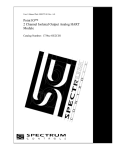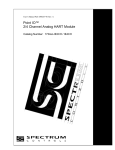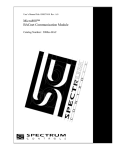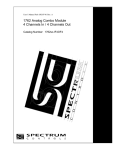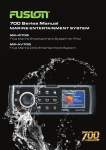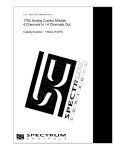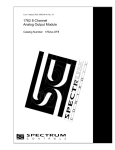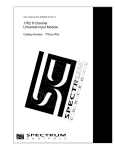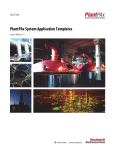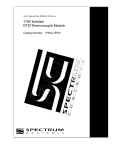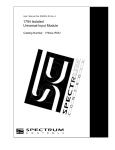Download Manual - Spectrum Controls, Inc.
Transcript
User’s Manual Pub. 0300266-01 Rev. A
Point IO™
4 Universal Analog Input Module
Catalog Number: 1734sc-IF4U
ii
Point IO™ 4 Channel Universal Analog Input Module
Important Notes
1.
Please read all the information in this owner’s guide before installing the
product.
2.
The information in this owner's guide applies to hardware Series A and firmware
version 1.00 or later.
3.
This guide assumes that the reader has a full working knowledge of the relevant
processor.
Notice
The products and services described in this owner's guide are useful in a wide variety of
applications. Therefore, the user and others responsible for applying the products and
services described herein are responsible for determining their acceptability for each
application. While efforts have been made to provide accurate information within this
owner's guide, Spectrum Controls assumes no responsibility for the accuracy,
completeness, or usefulness of the information herein.
Under no circumstances will Spectrum Controls be responsible or liable for any damages
or losses, including indirect or consequential damages or losses, arising out of either the
use of any information within this owner's guide or the use of any product or service
referenced herein.
No patent liability is assumed by Spectrum Controls with respect to the use of any of the
information, products, circuits, programming, or services referenced herein.
The information in this owner's guide is subject to change without notice.
Limited Warranty
Spectrum Controls warrants that its products are free from defects in material and
workmanship under normal use and service, as described in Spectrum Controls literature
covering this product, for a period of 1 year. The obligations of Spectrum Controls under
this warranty are limited to replacing or repairing, at its option, at its factory or facility,
any product which shall, in the applicable period after shipment, be returned to the
Spectrum Controls facility, transportation charges prepaid, and which after examination
is determined, to the satisfaction of Spectrum Controls, to be thus defective.
This warranty shall not apply to any such equipment which shall have been repaired or
altered except by Spectrum Controls or which shall have been subject to misuse, neglect,
or accident. In no case shall the liability of Spectrum Controls exceed the purchase price.
The aforementioned provisions do not extend the original warranty period of any product
which has either been repaired or replaced by Spectrum Controls.
User’s Manual Pub. 0300266-01 Rev. A
iii
Table of Contents
IMPORTANT NOTES ............................................................................................................................................ II NOTICE .............................................................................................................................................................. II LIMITED WARRANTY .......................................................................................................................................... II CHAPTER 1 MODULE OVERVIEW ..................................................................................................................... 1‐1 SECTION 1.1 GENERAL DESCRIPTION .............................................................................................................................. 1‐1 SECTION 1.2 INPUT TYPES ............................................................................................................................................ 1‐1 SECTION 1.3 DATA FORMATS ....................................................................................................................................... 1‐2 SECTION 1.4 FILTER FREQUENCIES ................................................................................................................................ 1‐2 SECTION 1.5 HARDWARE FEATURES .............................................................................................................................. 1‐2 1.5.1 LED Indicators ........................................................................................................................................... 1‐3 SECTION 1.6 SYSTEM OVERVIEW ................................................................................................................................... 1‐4 1.6.1 Module Power‐up ..................................................................................................................................... 1‐5 1.6.2 Module Operation ..................................................................................................................................... 1‐5 CHAPTER 2 INSTALLATION AND WIRING .......................................................................................................... 2‐1 SECTION 2.1 COMPLIANCE TO EUROPEAN UNION DIRECTIVES ............................................................................................. 2‐1 2.1.1 EMC Directive ............................................................................................................................................ 2‐1 2.1.2 Low Voltage Directive ............................................................................................................................... 2‐1 SECTION 2.2 POWER REQUIREMENTS ............................................................................................................................ 2‐1 SECTION 2.3 GENERAL CONSIDERATIONS ........................................................................................................................ 2‐2 2.3.1 Hazardous Location Considerations .......................................................................................................... 2‐2 2.3.2 Prevent Electrostatic Discharge ................................................................................................................ 2‐3 2.3.3 Remove Power .......................................................................................................................................... 2‐3 2.3.4 Selecting a Location .................................................................................................................................. 2‐3 SECTION 2.4 MOUNTING ............................................................................................................................................. 2‐3 2.4.1 Before You Begin ....................................................................................................................................... 2‐3 2.4.2 Install Mounting Base ............................................................................................................................... 2‐5 2.4.3 Install the I/O Module ............................................................................................................................... 2‐5 2.4.4 Install the Removable Terminal Block (RTB) ............................................................................................. 2‐6 2.4.5 Remove a Mounting Base ......................................................................................................................... 2‐6 2.4.6 Install a 1734‐TOPS Base .......................................................................................................................... 2‐7 2.4.7 Remove a 1734‐TOPS Base ....................................................................................................................... 2‐7 SECTION 2.5 FIELD WIRING CONNECTIONS ...................................................................................................................... 2‐7 2.5.1 Wiring Diagram ........................................................................................................................................ 2‐8 CHAPTER 3 CONFIGURING THE 1734SC‐IF4U USING RSLOGIX 5000 ................................................................... 3‐1 SECTION 3.1 INTRODUCTION ........................................................................................................................................ 3‐1 SECTION 3.2 ABOUT COMMUNICATIONS......................................................................................................................... 3‐1 SECTION 3.3 USE GENERIC PROFILE ............................................................................................................................... 3‐2 3.3.1 Add a Local Ethernet Bridge Module ........................................................................................................ 3‐3 3.3.2 Add a Remote Ethernet Point IO Adapter ................................................................................................. 3‐4 3.3.3 Add the Generic Point IO Module ............................................................................................................. 3‐6 SECTION 3.4 USE ADD‐ON‐PROFILE .............................................................................................................................. 3‐7 3.4.1 Installing the Add‐On profile ..................................................................................................................... 3‐8 3.4.2 Adding the IF4U Module To Your Logix Project ........................................................................................ 3‐8 SECTION 3.5 MODULE CONFIGURATION....................................................................................................................... 3‐10 3.5.1 Channel Configuration Details ................................................................................................................ 3‐12 SECTION 3.6 READ INPUT DATA ................................................................................................................................. 3‐16 3.6.1 Input Assembly Status Bit Definitions ..................................................................................................... 3‐17 APPENDIX A MODULE SPECIFICATIONS ............................................................................................................ A‐1 User’s Manual Pub. 0300266-01 Rev. A
iv
Point IO™ 4 Channel Universal Analog Input Module
PREFACE Read this preface to familiarize yourself with the rest of the manual. This preface covers
the following topics:
Who should use this manual
How to use this manual
Related publications
Conventions used in this manual
Rockwell Automation support
Who Should
Use This Manual
Use this manual if you are responsible for designing, installing, programming, or
troubleshooting control systems that use Allen-Bradley I/O and/or compatible controllers,
such as CompactLogix and ControlLogix.
How to Use
This Manual
As much as possible, we organized this manual to explain, in a task-by-task manner, how
to install, configure, program, operate and troubleshoot a control system using the
1734sc-IF4U.
Related
Documentation
The table below provides a listing of publications that contain important information
about Allen-Bradley PLC systems.
For
A description and
overview of the 1734 and
1734D series POINT I/O
modules
and compatible control
platforms. Also includes
an overview of how to
specify
a POINT I/O system.
Information about how to
install the 1734-EP24DC,
Series B POINT I/O 24V
dc Expansion Power
Supply.
Information about how to
install 1734-TB and -TBS
POINT I/O Wiring Base
Assemblies
Information about how to
install 1734-TB3 and TB3S POINT I/O Wiring
Base
Assemblies.
User’s Manual Pub. 0300266-01 Rev. A
Refer to this
Document
POINT I/O Selection
Guide
Allen-Bradley
Pub. No.
1734-SG001
Expansion Power
Supply Installation
Instructions
1734-IN058
Wiring Base Assembly
Installation Instructions
1734-IN511
Wiring Base Assembly
Installation Instructions
1734-IN013
v
If you would like a manual, you can:
Download a free electronic version from the internet at
www.theautomationbookstore.com
Purchase a printed manual by:
o Contacting your local distributor or Rockwell Automation
representative
o Visiting www.theautomationbookstore.com and placing your order
o Calling 1.800.963.9548 (USA/Canada) or 001.330.725.1574
(Outside USA/Canada)
Conventions
Used in This
Manual
The following conventions are used throughout this manual:
Bulleted lists (like this one) provide information not procedural steps.
Numbered lists provide sequential steps or hierarchical information.
Italic type is used for emphasis
Bold type identifies headings and sub-headings
!
Attention Are used to identify critical information to the reader
User’s Manual Pub. 0300266-01 Rev. A
vi
Point IO™ 4 Channel Universal Analog Input Module
User’s Manual Pub. 0300266-01 Rev. A
Chapter 1
Module Overview
The 1734sc-IF4U module has four analog input channels that support current, voltage,
RTD, resistance and thermocouple input types. This chapter includes information about:
General description
Input types
Data Formats
Filter frequencies
Hardware Features
System overview and module operation
Section 1.1
General
Description
The IF4U module digitally converts and stores analog data for each configured input.
Each input channel can be independently configured for input type, data format and filter
frequency.
Section 1.2
Input Types
The IF4U module supports the following input types.
Table 1-1 (Input Types)
Input Type
Range
E Type Thermocouple -270 to 1000 ˚C
J Type Thermocouple -210 to 1200 ˚C
K Type Thermocouple -270 to 1370 ˚C
T Type Thermocouple -270 to 400 ˚C
100 Ω Pt α 0.385
-200 to 850 ˚C
1000 Ω Pt α 0.385
-200 to 850 ˚C
100 Ω Pt α 0.3916
-200 to 630 ˚C
1000 Ω Pt α 0.3916
-200 to 630 ˚C
Resistance
0 to 3000 Ω
+/- 50 mV
+/- 100 mV
+/- 1 V
Voltage
0 to 5V
1 to 5V
+/- 10V
0 to 10V
4 to 20 mA
Current
0 to 20 mA
CJC
-25 to 85 ˚C
User’s Manual Pub. 0300266-01 Rev. A
(-454 to 1832 ˚F)
(-346 to 2192 ˚F)
(-454 to 2498 ˚F)
(-270 to 752 ˚F)
(-328 to 1562 ˚F)
(-328 to 1562 ˚F)
(-328 to 1166 ˚F)
(-328 to 1166 ˚F)
1-2
Point IO™ 4 Channel Universal Analog Input Module
Section 1.3
Data Formats
For each channel the data can be configured for:
Engineering Units x1
Engineering Units x10
Scaled-for-PID
Raw/proportional counts
Section 1.4
Filter
Frequencies
The module uses a notch filter to provide noise rejection for each input channel. The filter
for each channel is programmable allowing you to select from 4 different filter options:
4.17 Hz
16.7 Hz
62 Hz
470 Hz
Section 1.5
Hardware
Features
Channels are wired as differential inputs.
Module configuration is done via the controller’s programming software. The module
configuration is stored in the memory of the controller. Refer to your controller’s user
manual for more information. The illustration below shows the module’s hardware
features.
User’s Manual Pub. 0300266-01 Rev. A
Chapter 1: Module Overview
Figure 1
Figure 2
1.5.1 LED Indicators
The 1734 analog HART module uses several LEDs to show operational status. The
status LEDs are defined below:
Table 1-2 (LED Status Indicators)
Indicator
State
Description
Module
Status
Off
No power applied to device
Solid Green
Device operating normally
User’s Manual Pub. 0300266-01 Rev. A
1-3
1-4
Point IO™ 4 Channel Universal Analog Input Module
Indicator
Channel
Status
Network
Status
State
Description
Flashing
Green
Device needs commissioning due to configuration missing,
incomplete, or incorrect.
NOTE: The module always sets default values for invalid
configurations. Therefore, this status will not be shown.
Flashing Red
Not used with this module.
Solid Red
Recoverable fault.
ADC communications fault, or backplane communications
error.
Flashing
Red/Green
Device is in self-test mode.
This is only used during factory test and power-up.
Off
Channel disabled. Will remain off after power-up until
connection established. Analog processing will not take place
if no connection is made.
Solid Green
Normal (channel scanning inputs)
Flashing
Green
Calibration mode.
Solid Red
Major channel fault.
ADC communications fault.
Analog values will remain at current state until fault has
recovered.
Flashing Red
Channel at end of range
Flashing
Red/Green
Displayed during power-up.
Off
Device not powered/Not online.
Solid Green
Device operational AND online AND connected.
Flashing
Green
Device operational AND online but not connected.
-ORDevice online AND device needs commissioning.
Flashing Red
Minor fault AND/OR connection timeout AND/OR no
network power.
Solid Red
Critical fault OR critical link failure.
Flashing
Red/Green
Communication faulted and received an identify comm fault
request - long protocol.
Also displayed during power-up.
Section 1.6
System
Overview
The module communicates to the controller via a 1734 Control Net, Device Net or
Ethernet adapter. The module receives 5 and 24V dc power through the bus interface.
User’s Manual Pub. 0300266-01 Rev. A
Chapter 1: Module Overview
1-5
1.6.1 Module Power-up
At power-up, the module performs a check of its internal circuits, memory, and basic
functions. If no faults are found during power-up diagnostics, the module status LED is
turned on.
After power-up checks are complete, the module waits for valid channel configuration
data. If an invalid configuration is detected, the module will generate a PLC fault. Once
a channel is properly configured and enabled, it continuously converts the input data to a
value within the range selected for that channel.
1.6.2 Module Operation
The 1734sc-IF4U module provides four independent analog input channels. Each
channel includes four selectable filter settings and can be configured for voltage,
thermocouple, current, resistance or RTD input types.
The 1734sc-IF4U module utilizes a 20-bit Sigma-Delta ADC (Analog to Digital
Converter) to achieve 18-bit resolution. Inputs to the ADC are first multiplexed through
analog switches then buffered by a precision, low offset and drift, programmable gain
amplifier. The ADC also provides the programmable current source used in resistive
measurements.
The 1734sc-IF4U plug-in module communicates over its isolated CAN Bus interface
through the module backplane. The 1734 network adapter then communicates to the PLC
controller. See the block diagram below.
Isolation
Barrier
Analog_0
CAN Bus
and +5VDC
Point Bus
I
s
o
l
a
t
i
o
n
Isolation
Barrier
+24VDC
GND
User’s Manual Pub. 0300266-01 Rev. A
Analog_1
SPI Interface
Isolated
CAN Bus
ADC
Analog_2
Current Srcs
Processor
SPI Interface
PGA_Interrupt
Controls
Low
Input‐Power
Interrupt
and
System_Reset
Power Supplies
And
Power Monitor
Protection,
Filtering,
Analog
Switch
Matrix,
PGA
Voltage / Current (4‐chs)
Thermocouple (3‐chs)
RTD / Resistance (2/4‐chs)
CJC (1‐ch)
LEDs
Controls and Status
CLK
System Clock
Generator
+15VDC ±3VDC
+3.3VDC ±2%
GND
‐15VDC ±3VDC
Notes:
1) I/O’s are ESD protected
1-6
Point IO™ 4 Channel Universal Analog Input Module
User’s Manual Pub. 0300266-01 Rev. A
Chapter 2
Installation and Wiring
This chapter will cover:
Compliance to European union directives
Power requirements
General considerations
Mounting
Field wiring connections
Section 2.1
Compliance to
European
Union Directives
This product is approved for installation within the European Union and EEA regions. It
has been designed and tested to meet the following directives.
2.1.1 EMC Directive
The 1734sc-IF4U module is tested to meet Council Directive 89/336/EEC
Electromagnetic Compatibility (EMC) and the following standards, in whole or in part,
documented in a technical construction file:
IEC 61000-6-4 Electromagnetic compatibility (EMC) - Part 6-4: Generic
standards - Emission standard for industrial environments
IEC 61000-6-2 Electromagnetic compatibility (EMC) – Part 6-2: Generic
standards – Immunity for industrial environments
This product is intended for use in an industrial environment.
2.1.2 Low Voltage Directive
This product is tested to meet Council Directive 73/23/EEC Low Voltage, by applying
the safety requirements of EN 61131-2Programmable Controllers, Part 2 – Equipment
Requirements and Tests. For specific information required by EN61131-2, see the
appropriate sections in this publication, as well as the following Allen-Bradley
publications:
Industrial Automation, Wiring and Grounding Guidelines for Noise Immunity,
publication 1770-4.1
Automation Systems Catalog, publication B113
Section 2.2
Power
Requirements
The module receives power through the bus interface from the +5V dc/+24V dc system
power supply. The maximum current drawn by the module is shown in the table below.
User’s Manual Pub. 0300266-01 Rev. A
2-2
Point IO™ 4 Channel Universal Analog Input Module
5 VDC
24 VDC
15 mA (max)
20 mA (max)
Use the table below to determine the maximum number of IF4U modules that can be
installed in a MicroLogix system.
Section 2.3
General
Considerations
1734 I/O is suitable for use in an industrial environment when installed in accordance
with these instructions. Specifically, this equipment is intended for use in clean, dry
environments Pollution degree 21 and to circuits not exceeding Over Voltage Category
II2(IEC 60664-1)3.
2.3.1 Hazardous Location Considerations
This equipment is suitable for use in Class I, Division 2, Groups A, B, C, D or nonhazardous locations only. The following WARNING statement applies to use in
hazardous locations.
!
Attention
EXPLOSION HAZARD
Substitution of components may impair suitability for Class I,
Division 2.
Do not replace components or disconnect equipment unless
power has been switched off or the area is known to be nonhazardous.
Do not connect or disconnect components unless power has
been switched off or the area is known to be non-hazardous.
This product must be installed in an IP54 rated enclosure.
All wiring must comply with N.E.C. article 501-4(b).
1
Pollution Degree 2 is an environment where, normally, only non-conductive pollution occurs except that
occasionally a temporary conductivity caused by condensation shall be expected.
2
Over Voltage Category II is the load level section of the electrical distribution system. At this level
transient voltages are controlled and do not exceed the impulse voltage capability of the product’s
insulation.
3
Pollution Degree 2 and Over Voltage Category II are International Electrotechnical Commission (IEC)
designations.
User’s Manual Pub. 0300266-01 Rev. A
Chapter 2: Installation and Wiring
2-3
2.3.2 Prevent Electrostatic Discharge
!
Attention
Electrostatic discharge can damage integrated circuits or
semiconductors if you touch analog I/O module bus connector pins or
the terminal block on the input module. Follow these guidelines when
you handle the module:
Touch a grounded object to discharge static potential.
Wear an approved wrist-strap grounding device.
Do not touch the bus connector or connector pins.
Do not touch circuit components inside the module.
If available, use a static-safe work station.
When it is not in use, keep the module in its static-shield bag.
2.3.3 Remove Power
!
Attention
Remove power before removing or inserting this module. When you
remove or insert a module with power applied, an electrical arc may
occur. An electrical arc can cause personal injury or property damage
by:
Sending an erroneous signal to your system’s field devices,
causing unintended machine motion
Causing an explosion in a hazardous environment
Electrical arcing causes excessive wear to contacts on both the module
and its mating connector and may lead to premature failure.
2.3.4 Selecting a Location
Reducing Noise
Most applications require installation in an industrial enclosure to reduce the effects of
electrical interference. Analog inputs are highly susceptible to electrical noise. Electrical
noise coupled to the analog inputs will reduce the performance (accuracy) of the module.
Group your modules to minimize adverse effects from radiated electrical noise and heat.
Consider the following conditions when selecting a location for the analog module.
Position the module:
Away from sources of electrical noise such as hard-contact switches, relays, and
AC motor drives
Away from modules which generate significant radiated heat. Refer to the
module’s heat dissipation specification.
In addition, route shielded, twisted-pair analog input wiring away from any high voltage
I/O wiring.
Section 2.4
Mounting
2.4.1 Before You Begin
Note that this series C product can be used with the following:
ControlNet and EtherNet/IP adapters ONLY, using RSLogix 5000 software,
version 11 or later
See the figures to familiarize yourself with major parts of the module, noting that the
User’s Manual Pub. 0300266-01 Rev. A
2-4
Point IO™ 4 Channel Universal Analog Input Module
wiring base assembly is one of the following:
1734-TB or 1734-TBS POINT I/O two-piece terminal base, which includes the
1734-RTB removable terminal block and 1734-MB mounting base
1734-TOP or 1734-TOPS POINT I/O one-piece terminal base
User’s Manual Pub. 0300266-01 Rev. A
Chapter 2: Installation and Wiring
2-5
2.4.2 Install Mounting Base
!
Attention
During panel or DIN rail mounting of all devices, be sure that all debris
(metal chips, wire strands, etc.) is kept from falling into the module.
Debris that falls into the module could cause damage when power is
applied to the module.
To install the mounting base on the DIN rail, proceed as follows:
1.) Position the mounting base vertically above the installed units (adapter, power
supply or existing module.
2.) Slide the mounting base down allowing the interlocking side pieces to engage
the adjacent module or adapter.
3.) Press firmly to seat the mounting base on the DIN rail. The mounting base will
snap into place.
4.) To remove the mounting base from the DIN rail, remove the module, and use a
small bladed screwdriver to rotate the base locking screw to a vertical position.
This releases the locking mechanism. Then lift straight up to remove.
2.4.3 Install the I/O Module
The module can be installed before, or after base installation. Make sure that the
mounting base is correctly keyed before installing the module into the mounting base. In
addition, make sure the mounting base locking screw is positioned horizontal referenced
to the base.
User’s Manual Pub. 0300266-01 Rev. A
2-6
Point IO™ 4 Channel Universal Analog Input Module
1.) Using a bladed screwdriver, rotate the key switch on the mounting base
clockwise until the number required for the type of module being installed aligns
with the notch in the base.
2.) Make certain the DIN rail locking screw is in the horizontal position. (You
cannot insert the module if the locking mechanism is unlocked.)
3.) Insert the module straight down into the mounting base and press to secure. The
module will lock into place.
2.4.4 Install the Removable Terminal Block (RTB)
A removable terminal block is supplied with your wiring base assembly. To remove the
terminal block, pull up on the RTB handle. This allows the mounting base to be removed
and replaced as necessary without removing any of the wiring. To reinsert the removable
terminal block, proceed as follows.
1.) Insert the end opposite the handle into the base unit. This end has a curved
section that engages with the wiring base.
2.) Rotate the terminal block into the wiring base until it locks itself in place.
3.) If an I/O module is installed, snap the RTB handle into place on the module.
2.4.5 Remove a Mounting Base
To remove a mounting base, you must remove any installed module, and the module
installed in the base to the right. Remove the removable terminal block (if wired).
1.) Unlatch the RTB handle on the I/O module.
2.) Pull on the RTB handle to remove the removable terminal block.
3.) Press on the module lock on the top of the module.
4.) Pull on the I/O module to remove from the base.
5.) Repeat steps 1, 2, 3 and 4 for the module to the right.
6.) Use a small bladed screwdriver to rotate the orange base locking screw to a
User’s Manual Pub. 0300266-01 Rev. A
Chapter 2: Installation and Wiring
2-7
vertical position.
This releases the locking mechanism.
7.) Lift straight up to remove.
2.4.6 Install a 1734-TOPS Base
1.) Position the base vertically above the installed units, such as an adapter, power
supply, or existing module.
2.) Slide the base down, allowing the interlocking side pieces to engage the adjacent
installed unit.
3.) Press firmly to seat the base on the DIN rail until the base snaps into place.
4.) Verify that the DIN-rail locking screw is in a horizontal, locked position before
inserting an I/O module.
2.4.7 Remove a 1734-TOPS Base
To remove a wiring base from the DIN rail, you must remove the module installed to the
right of the base.
1.) Squeeze the module locking mechanism of the module to the right of the base,
pulling up to remove the module.
2.) Turn the orange locking screw to a vertical position to unlock the base from the
DIN rail.
3.) Slide the base up to release it from its mating units.
Section 2.5
Field Wiring
Connections
Consider the following when wiring your system:
General
Power and input wiring must be in accordance with Class 1, Division 2 wiring
methods, Article 501-4(b) of the National Electric Code, NFPA 70, and in
accordance with the authority having jurisdiction.
Use Belden™ 8761, or equivalent, shielded wire.
To ensure optimum accuracy, limit overall cable impedance by keeping a cable
as short as possible. Locate the module as close to input devices as the
application permits.
Digital and analog power must be supplied by an Isolated Secondary Limited
Energy Low Voltage source.
Inputs
The module provides loop power for analog inputs.
User’s Manual Pub. 0300266-01 Rev. A
2-8
Point IO™ 4 Channel Universal Analog Input Module
Grounding
USE SUPPLY WIRES SUITALE FOR 10°C ABOVE
SURROUNDING AMBIENT
!
Attention
UTILISER DES FILS D’ALIMENTATION QUI CONVIENNENT A
UNE TEMPERATURE DE 10°C AU-DESSUS DE LA
TEMPERATURE AMBIANTE
!
Attention
This product is intended to be mounted to a well-grounded mounting surface
such as a metal panel. Additional grounding connections from the module’s
mounting tabs or DIN rail (if used) are not required unless the mounting surface
cannot be grounded.
Under normal conditions, the drain wire (shield) should be connected to the
metal mounting panel (earth ground). Keep shield connection to earth ground as
short as possible.
Ground the shield drain wire at one end only. The typical location is as follows:
o
For grounded thermocouples or millivolt sensors, this is at the sensor
end.
o
For insulated/ungrounded thermocouples, this is at the module end.
Contact your sensor manufacturer for additional details.
Refer to Industrial Automation Wiring and Grounding Guidelines, AllenBradley publication 1770-4.1, for additional information.
Noise Prevention
Route field wiring away from any other wiring and as far as possible from
sources of electrical noise, such as motors, transformers, contactors, and ac
devices. As a general rule, allow at least 15.2 cm (6 in.) of separation for every
120V of power.
Routing field wiring in a grounded conduit can reduce electrical noise.
If field wiring must cross ac or power cables, ensure that they cross at right
angles.
If noise persists for a device, try grounding the opposite end of the cable shield
or ground both ends of the shield.
2.5.1 Wiring Diagram
Refer to the following wiring diagrams for field wiring connections.
Table 2-1 (Terminal Block Pinout)
RTB Pin#
Usage
Usage
RTB Pin#
0
Ch 0+
Ch 2+
1
2
Ch 0Ch 23
4
Ch 1+
Ch 3+
5
6
Ch 1Ch 37
User’s Manual Pub. 0300266-01 Rev. A
Chapter 2: Installation and Wiring
2-9
Figure 3 (Voltage, Current and Thermocouple)
2-wire
XMTR
CJC Sensor
Thermocouple
Input
0
Ch 0+
1
Ch 2+
2
Ch 0-
3
Ch 2-
4
Ch 1+
5
Ch 3+
6
Ch 1-
7
Ch 3-
-
+
+
-
24V PWR
Supply
+
-
4 to 20 mA
Input
Voltage
Input
Note: The CJC sensor shown in the diagram above can only be installed
across terminals 0 and 2.
Figure 4 (Three, and Four Wire RTD)
0
Ch 0+
1
Ch 2+
2
Ch 0-
3
Ch 2-
4
Ch 1+
5
Ch 3+
6
Ch 1-
7
Ch 3-
4-wire RTD
3-wire RTD
External
Jumper
Figure 5 (2-Wire RTD and Resistance)
2-wire RTD
or
Resistance
2-wire RTD
or
Resistance
0
Ch 0+
1
Ch 2+
2
Ch 0-
3
Ch 2-
4
Ch 1+
5
Ch 3+
6
Ch 1-
7
Ch 3-
2-wire RTD
or
Resistance
2-wire RTD
or
Resistance
Note: The IF4U supports several input types and can be configured for one
of the following input combinations:
4-channels Voltage + mV + Current
3-Channels Thermocouple
2-Channels 3/4-Wire RTD
4-Channels 2-Wire RTD/Resistance
Or a combination of two or more input types listed above (Ex., 1
Channel of Thermocouple and 1 Channel of 3/4-wire RTD)
User’s Manual Pub. 0300266-01 Rev. A
2-10
Point IO™ 4 Channel Universal Analog Input Module
User’s Manual Pub. 0300266-01 Rev. A
Chapter 3
Configuring the 1734sc-IF4U
Using RSLogix 5000
This chapter covers the following subjects:
Things you should know
About Communications
Use Generic Profile
Use AOP (Add On Profile)
Module configuration
Reading input data
Module update time
Section 3.1
Introduction
This chapter will describe how to configure the IF4U module using RSLogix 5000
programming software.
Section 3.2
About
Communications
The module produces and consumes data as follows:
IF4U Produce/Consume Data
Instance:
Description:
Total Size:
100
Analog Only
16 Bytes RSL5K (Dnet 12 bytes)
Bit
15 14 13 12 11 10 09 08 07 06 05 04 03 02 01 00
Analog
data
Channel 0 Data - INT
12 bytes
Channel 2 Data - INT
0x000x0B
Channel 3 Data - INT
Channel 1 Data - INT
Status Byte for Channel 1
Status Byte for Channel 0
n/a n/a n/a OC OR UR n/a CF n/a n/a n/a OC OR UR n/a CF
Status Byte for Channel 3
Status Byte for Channel 2
n/a n/a n/a OC OR UR n/a CF n/a n/a n/a OC OR UR n/a CF
User’s Manual Pub. 0300266-01 Rev. A
3-2
Point IO™ 4 Channel Universal Analog Input Module
!
The IF4U module is not compatible with the 1734-ADN, ADN(X), and
PDN device net adapters and the 1734-APB profibus adapter.
Attention
!
The 1734sc-IF4U is not field upgradable.
Attention
!
The ControlNet adapter (1734-ACNR) has a maximum data transmit
limit of 600 bytes. Therefore, the maximum number of 1734sc-IF4U
modules that can be installed behind a ControlNet adapter is 14.
Attention
Section 3.3
Use Generic
Profile
The generic point IO module profile can be used to represent the IF4U module within
RSLogix 5000. The generic profile should be used for RSLogix 5000 versions 14 and
older. Before the generic profile can be added to the IO configuration, the proper
communication module needs to be added to the IO configuration first. Follow the
procedure below to add a communication module to RSLogix 5000.
1.) Add the new local communication module to your project.
2.) Configure the local module, including:
a.
Naming the module
b.
Choosing a Communication Format
c.
Setting the Revision level
d.
Setting the module location as necessary such as the slot number for a
1756-CNB module
e.
Choosing an Electronic Keying method
3.) Add the new remote module to your project, such as a 1734 Control Net adapter
or Ethernet Adapter (i.e. 1734-ACNR or 1734-AENT, respectively).
4.) Configure the remote module similarly to the local module
5.) Download the configuration to the controller
Note: If you are using Control Net, you must schedule the network using
“RSNetworks for Control Net” after adding the local and remote
communication modules.
Note: When you create a new RSLogix 5000 project with the CompactLogix
1769-L32C or L35CR controller, The Controller Organizer creates a Control
Net port in the local chassis. In this case, you don’t need to add a separate
local communication module.
User’s Manual Pub. 0300266-01 Rev. A
Chapter 3: Configuring the 1734sc-IF4U for RSLogix 5000
3-3
Note: When you create a new RSLogix 5000 project with the CompactLogix
1769-L23E, 1769-L32E or L35E controller, The Controller Organizer creates
a Ethernet port in the local chassis. In this case, you don’t need to add a
separate local communication module.
3.3.1 Add a Local Ethernet Bridge Module
After you have started RSLogix 5000 software and created a controller project, you can
add Ethernet communication modules. A local Ethernet communication module is a
module that resides in the same chassis as the controller.
1.) Select a New Module for the I/O Configuration.
Right-click on I/O
Configuration
Select New Module
2.) Select the module type from the Select Module Type pop-up. The example
below uses a 1756-ENBT module.
Select the local Ethernet
bridge module
Click OK
User’s Manual Pub. 0300266-01 Rev. A
3-4
Point IO™ 4 Channel Universal Analog Input Module
3.) Configure the local Ethernet bridge module.
Name the module
Enter IP address of ENBT
Select the module’s slot number
Select the module’s revision
level
Select electronic keying level
Click OK
3.3.2 Add a Remote Ethernet Point IO Adapter
After you have added the local Ethernet communication module, you must add remote
Ethernet communication modules. A remote Ethernet module is a module that resides in a
separate chassis from the controller.
!
If you plan to use the 1734 Control Net adapter, you will need to install
the 1734sc-IF4U EDS file before scheduling the network. The latest
EDS files can be found at (www.spectrumcontrols.com).
Attention
1.) Select a New Module for the I/O Configuration.
User’s Manual Pub. 0300266-01 Rev. A
Chapter 3: Configuring the 1734sc-IF4U for RSLogix 5000
3-5
Right-click on the local
communication module
Select New Module
2.) Select the module type from the Select Module Type pop-up.
Select the remote Ethernet
communication module.
Click OK
3.) Configure the remote Ethernet communication module.
User’s Manual Pub. 0300266-01 Rev. A
3-6
Point IO™ 4 Channel Universal Analog Input Module
Name the module
Enter IP address of ENBT
Select the comm. format
Select the chassis size
Select the module revision
level
Select electronic keying level
Click OK
3.3.3 Add the Generic Point IO Module
After adding the remote Ethernet communication module, the 1734 Generic Module must
be added. The following steps must be followed to add the 1734 Generic IO Module.
1.) Select a New Module for the I/O Configuration.
Right-click on the
remote communication
Select New Module
2.) Select the module type from the Select Module Type pop-up.
User’s Manual Pub. 0300266-01 Rev. A
Chapter 3: Configuring the 1734sc-IF4U for RSLogix 5000
3-7
Select Generic
Module
Click OK
3.) Configure the Generic 1734 Module (i.e. 1734sc-IF4U)
Name the module
Enter “Input Data – SINT”
for Comm. Format
Enter module slot #
Enter the input assembly
instance and size.
Enter the output
assembly (always 190) Click OK
Enter the configuration
assembly instance and
size.
Section 3.4
Use
Add-On-Profile
For RSLogix 5000 version 15 and greater an Add-On module profile is available for
download at (http://www.spectrumcontrols.com/downloads.htm). The Add-On profile
allows the user to add the IF4U module to the RSLogix 5000 module pick list. The
profile provides configuration and information screens to the user to simplify installation.
Follow the procedure below to install and use the Add-On profile.
User’s Manual Pub. 0300266-01 Rev. A
3-8
Point IO™ 4 Channel Universal Analog Input Module
3.4.1 Installing the Add-On profile
1.) Download the zipped file from the Spectrum Controls website and unzip
the file (http://www.spectrumcontrols.com/downloads.htm)
2.)
Open the created folder and double-click on the MPSetup.exe file.
3.) Follow the online prompts.
3.4.2 Adding the IF4U Module To Your Logix Project
Once the profiles are installed you can access them through RSLogix 5000 via the I/O
Configuration. Follow the procedure below to add a module:
1.) Before you can add the 1734sc-IF4U to your RSLogix 5000 project, you must
first add a local communication module and a remote communication adapter.
Complete sections 3.3.1 and 3.3.2 above, before proceeding to step 2 below.
2.) In the I/O Configuration, right mouse click on the Point IO backplane under the
remote communication adapter that you added in step one above and select
“New Module”.
3.) When the dialog screen opens, select the “By Vender” tab and expand the
Spectrum Controls folder.
User’s Manual Pub. 0300266-01 Rev. A
Chapter 3: Configuring the 1734sc-IF4U for RSLogix 5000
4.) Highlight the module and press the “OK” button.
5.) Give the module a unique name.
Name the module
6.) Enter an RPI Rate
User’s Manual Pub. 0300266-01 Rev. A
3-9
3-10
Point IO™ 4 Channel Universal Analog Input Module
Set the RPI rate
7.) Configure the rest of the module using the “Module Configuration” tab.
Section 3.5
Module
Configuration
The IF4U can be configured using the AOP (Add-On-Profile) or by using the 1734
generic module profile. The configuration tags for the IF4U are located under the
controller tags. The following examples describe the tag structure allocated by the
Generic Module profile and the AOP.
User’s Manual Pub. 0300266-01 Rev. A
Chapter 3: Configuring the 1734sc-IF4U for RSLogix 5000
3-11
Generic Module Profile:
[Name of remote communication module]:e:x.Data[0 to 198]
e = IF4U slot number
x = Image Type (i.e. C, I, or O)
AOP (Add-On-Profile):
[Name of remote communication module]:e:x
e = IF4U slot number
x = Image Type (i.e. C, I, or O)
Note: The AOP will provide a predefined tag structure for the
configuration. See example below.
Figure 6 (AOP Config. Tags)
Table 3-1 (IF4U Configuration Assembly)
Instance:
225 (0xE1)
OFFSET
0x00
Size:
12 bytes RSL5K (Dnet 8 bytes)
FIELD
Channel 0 Configuration
(See section “Channel Configuration Details”
below)
TYPE
BYTES
INT
2
0x02
Channel 1 Configuration (Same as above)
INT
2
0x04
Channel 2 Configuration (Same as above)
INT
2
0x06
Channel 3 Configuration (Same as above)
INT
2
User’s Manual Pub. 0300266-01 Rev. A
3-12
Point IO™ 4 Channel Universal Analog Input Module
3.5.1 Channel Configuration Details
Make these bit settings
To Select
15
Channel Enable
Filter Frequency
(Ignored if Display
CJC)
CJC Disable
Open Circuit
(Ignored if Display
CJC)
Input Type
Data Format
2/3/4 Wire RTD
(Only valid for RTD/R
ranges)
Temperature Scale
(Only valid for
temperature ranges)
14
13
12
11
10
09
08
07
06
05
04
03
02
01
Enable (Default)
0
1
Disable
17 Hz (Default)
0
0
4 Hz
0
1
62 Hz
1
0
470 Hz
1
1
Enable (Default)
0
Disable
1
Upscale (Default)
0
0
Downscale
0
1
Zero
1
0
N/A
1
1
-10 to 10 V (Default)
0
0
0
0
0
0 to 10 V
0
0
0
0
1
1 to 5 V
0
0
0
1
0
0 to 5 V
0
0
0
1
1
±1V
0
0
1
0
0
±100 mV
0
0
1
0
1
±50 mV
0
0
1
1
0
4 to 20 mA
0
0
1
1
1
0 to 20 mA
0
1
0
0
0
Type J TC
0
1
0
0
1
Type K TC
0
1
0
1
0
Type T TC
0
1
0
1
1
Type E TC
0
1
1
0
0
100 Pt 385
0
1
1
0
1
1000 Pt 385
0
1
1
1
0
100 Pt 3916
0
1
1
1
1
1000 Pt 3916
1
0
0
0
0
3000 ohm
1
0
0
0
1
CJC
1
0
0
1
0
Eng. Units X1 (Default)
0
0
Eng. Units X10
0
1
Raw/Proportional Data
1
0
Scaled for PID
1
1
3 Wire w/ Comp (Default)
0
0
4 Wire
0
1
2 Wire
1
0
Deg C (Default)
0
Deg F
1
User’s Manual Pub. 0300266-01 Rev. A
00
Chapter 3: Configuring the 1734sc-IF4U for RSLogix 5000
3-13
Channel Disable (Bit 0)
Enable (Default) = 0, Disable = 1. If the channel is disabled, all other fields are ignored. Filter Frequency (Bits 1 and 2)
The filter selection affects how the module attenuates the input signal at the specified
frequency. It also affects the update time of the input data which is reflected in the
minimum conversion time for each channel. Lower filter frequencies are recommended for RTD and Thermocouple modes. The total update time for the module can be calculated using the table below. Default setting is 17 Hz. Table 3-2 (Channel Conversion Time)
ADC Filter
Name
(Update
Frequency)
470 Hz
62 Hz
17 Hz
4 Hz
Conversion
Time
37 ms
65 ms
153 ms
512 ms
Step Response / Module
update Rate4
= Sum of conversion times for
each enabled channel
CJC Disable (Bit 3)
When this bit is set, no CJC compensation shall be applied to the channel if it is
configured as a thermocouple. Default setting is “enabled”.
Open Circuit Response (Bits 4 and 5)
The open circuit response defines the state of the channel data when an open-circuit or
short-circuit condition is detected. Default setting is upscale.
Response
Option
Definition
Upscale
Sets the input data value to full-scale value. The full-scale value is
determined by the selected input type and data format.
Downscale
Sets the input data value to minimum-scale value. The minimum-scale
value is determined by the selected input type and data format.
Zero
Sets the input data value to zero (0).
Input Type (Bits 6 through 10)
These bits specify the input type for each channel. If channel 0 or 2 is configured for multi‐wire RTD, the configuration for the adjacent odd channel (1, 3) is 4
The module update time is purely the sum of the conversion times for each enabled channel except
when a channel is configured for a 3-wire RTD. For each channel configured for a 3-wire RTD, double
the conversion time.
User’s Manual Pub. 0300266-01 Rev. A
3-14
Point IO™ 4 Channel Universal Analog Input Module
ignored. It is recommended to configure both channels identically (0 and 1, 2 and 3) when using multi‐wire RTD. This reduces confusion in the setup. A zero will be reported for the adjacent odd channel in multi‐wire RTD. The +/‐10V range is the default input type for each channel. Data Format (Bits 11 and 12)
Data Format dictates how the data is presented. Engineering Units X1 is the default. Table 3-3 (Data Formats)
Input Range
E Type TC
J Type TC
K Type TC
T Type TC
RTD
100 Ohm Pt 0.385
RTD
1000 Ohm Pt 0.385
RTD
100 Ohm Pt 0.392
RTD
1000 Ohm Pt 0.392
Resistance
User’s Manual Pub. 0300266-01 Rev. A
Input Value
Condition
EU x1
EU x10
Raw Prop
PID
1000.00 deg C
High Limit
10000
1000
32767
16383
1000.00 deg C
High Range
10000
1000
32767
16383
-270.00 deg C
Low Range
-2700
-270
-32768
0
-270.00 deg C
Low Limit
-2700
-270
-32768
0
1200.00 deg C
High Limit
12000
1200
32767
16383
1200.00 deg C
High Range
12000
1200
32767
16383
-210.00 deg C
Low Range
-2100
-210
-32768
0
-210.00 deg C
Low Limit
-2100
-210
-32768
0
1370.00 deg C
High Limit
13700
1370
32767
16383
1370.00 deg C
High Range
13700
1370
32767
16383
-270.00 deg C
Low Range
-2700
-270
-32768
0
-270.00 deg C
Low Limit
-2700
-270
-32768
0
400.00 deg C
High Limit
4000
400
32767
16383
400.00 deg C
High Range
4000
400
32767
16383
-270.00 deg C
Low Range
-2700
-270
-32768
0
-270.00 deg C
Low Limit
-2700
-270
-32768
0
850.00 deg C
High Limit
8500
850
32767
16383
850.00 deg C
High Range
8500
850
32767
16383
-200.00 deg C
Low Range
-2000
-200
-32768
0
-200.00 deg C
Low Limit
-2000
-200
-32768
0
850.00 deg C
High Limit
8500
850
32767
16383
850.00 deg C
High Range
8500
850
32767
16383
-200.00 deg C
Low Range
-2000
-200
-32768
0
-200.00 deg C
Low Limit
-2000
-200
-32768
0
630.00 deg C
High Limit
6300
630
32767
16383
630.00 deg C
High Range
6300
630
32767
16383
-200.00 deg C
Low Range
-2000
-200
-32768
0
-200.00 deg C
Low Limit
-2000
-200
-32768
0
630.00 deg C
High Limit
6300
630
32767
16383
630.00 deg C
High Range
6300
630
32767
16383
-200.00 deg C
Low Range
-2000
-200
-32768
0
-200.00 deg C
Low Limit
-2000
-200
-32768
0
3000.00 ohms
High Limit
30000
3000
32767
16383
Chapter 3: Configuring the 1734sc-IF4U for RSLogix 5000
3-15
Input Range
Input Value
Condition
EU x1
EU x10
Raw Prop
0..3000 Ohms
3000.00 ohms
High Range
30000
3000
32767
16383
0.00 ohms
Low Range
0
0
-32768
0
0.00 ohms
Low Limit
0
0
-32768
0
52.50 mV dc
High Limit
5250
525
Clipped
16793
50.00 mV dc
High Range
5000
500
32767
16383
-50.00 mV dc
Low Range
-5000
-500
-32768
0
-52.50 mV dc
Low Limit
-5250
-525
Clipped
-410
105.00 mV dc
High Limit
10500
1050
Clipped
16793
100.00 mV dc
High Range
10000
1000
32767
16383
-100.00 mV dc
Low Range
-10000
-1000
-32768
0
+/-50mV
+-100mV
-105.00 mV dc
Low Limit
-10500
-1050
Clipped
-410
High Limit
5250
525
Clipped
17202
5.00 V dc
High Range
5000
500
32767
16383
0.00 V dc
Low Range
0
0
-32768
0
0.00 V dc
Low Limit
0
0
-32768
0
5.25 V dc
High Limit
5250
525
Clipped
17407
5.00 V dc
High Range
5000
500
32767
16383
1.00 V dc
Low Range
1000
100
-32768
0
0.50 V dc
Low Limit
500
50
Clipped
-2048
10.50 V dc
High Limit
10500
1050
Clipped
16793
10.00 V dc
High Range
10000
1000
32767
16383
-10.00 V dc
Low Range
-10000
-1000
-32768
0
-10.50 V dc
Low Limit
-10500
-1050
Clipped
-410
10.50 V dc
High Limit
10500
1050
Clipped
17202
10.00 V dc
High Range
10000
1000
32767
16383
0.00 V dc
Low Range
0
0
-32768
0
5.25 V dc
0..5V
1..5V
+/-10V
0..10V
+/-1V
4..20mA
0..20mA
CJC
User’s Manual Pub. 0300266-01 Rev. A
PID
0.00 V dc
Low Limit
0
0
-32768
0
1.05 V dc
High Limit
10500
1050
Clipped
16793
1.00 V dc
High Range
10000
1000
32767
16383
-1.00 V dc
Low Range
-10000
-1000
-32768
0
-1.05 V dc
Low Limit
-10500
-1050
Clipped
-410
21.00 mA
High Limit
21000
2100
Clipped
17407
20.00 mA
High Range
20000
2000
32767
16383
4.00 mA
Low Range
4000
400
-32768
0
3.00 mA
Low Limit
3000
300
Clipped
-1024
21.00 mA
High Limit
21000
2100
Clipped
17202
20.00 mA
High Range
20000
2000
32767
16383
0.00 mA
Low Range
0
0
-32768
0
0.00 mA
Low Limit
0
0
-32768
0
85.00 deg C
High Limit
8500
850
Clipped
16383
85.00 deg C
High Range
8500
850
32767
16383
-25.00 deg C
Low Range
-2500
-250
-32768
0
-25.00 deg C
Low Limit
-2500
-250
Clipped
0
3-16
Point IO™ 4 Channel Universal Analog Input Module
2/3/4 Wire RTD (Bits 13 and 14)
These bits are used for RTD and Resistance modes only. They are used to specify 2, 3, or 4 wire RTD modes. This setting is ignored for non‐resistance/RTD input types. Default setting is 3‐wire. Temperature Scale (Bit 15)
Set to 1 to display degrees Fahrenheit. Otherwise 0 displays temperature in degrees Celsius (default). This field shall be ignored for non‐temperature ranges.
Section 3.6
Read Input
Data
The input data file contains module status information and analog input data for each of
the input channels. Analog input data is read for each channel, converted to a scaled
digital value, and stored in the input tags. The input tags for the IF4U are located under
the controller tags. The following examples describe the tag structure allocated by the
Generic Module profile and the AOP.
Generic Module Profile:
[Name of remote communication module]:e:x.Data[0 to 198]
e = IF4U slot number
x = Image Type (i.e. C, I, or O)
AOP (Add-On-Profile):
[Name of remote communication module]:e:x
e = IF4U slot number
x = Image Type (i.e. C, I, or O)
Note: The AOP will provide a predefined tag structure for the input tags.
See example below.
Figure 7 (AOP Input Tags)
User’s Manual Pub. 0300266-01 Rev. A
Chapter 3: Configuring the 1734sc-IF4U for RSLogix 5000
3-17
Table 3-4 (IF4U Input Assembly)
Instance:
Description:
Total Size:
100
Analog Only
16 Bytes RSL5K (Dnet 12 bytes)
Bit
15 14 13 12 11 10 09 08 07 06 05 04 03 02 01 00
Analog
data
Channel 0 Data - INT
12 bytes
Channel 2 Data - INT
0x000x0B
Channel 3 Data - INT
Channel 1 Data - INT
Status Byte for Channel 1
Status Byte for Channel 0
n/a n/a n/a OC OR UR n/a CF n/a n/a n/a OC OR UR n/a CF
Status Byte for Channel 3
Status Byte for Channel 2
n/a n/a n/a OC OR UR n/a CF n/a n/a n/a OC OR UR n/a CF
3.6.1 Input Assembly Status Bit Definitions
Under Range and Over Range trip points are determined by the Low Range and High
Range values in the Table 3-3 (Data Formats).
The CF bit is set when any of the other status bits are set.
CF = Channel Fault status; 0 = no error, 1 = fault
UR = Underrange; 0 = no error, 1 = fault
OR = Overrange; 0 = no error, 1 = fault
OC = Open Circuit: 0 = no error, 1 = fault (not valid for all ranges)
n/a = Always 0.
User’s Manual Pub. 0300266-01 Rev. A
3-18
Point IO™ 4 Channel Universal Analog Input Module
User’s Manual Pub. 0300266-01 Rev. A
Appendix A
Module Specifications
General Specifications
Parameter
Specification
Module location
1734-TBxx
Pointbus current
15 mA
Power dissipation
0.6 W maximum @ 28.8V dc
Thermal dissipation
Isolation Voltage
External DC power
Supply Voltage
Voltage Range
Supply Current
2.0 BTU/hr maximum @ 28.8V dc
50V (continuous), Basic Insulation Type,
No isolation between channels
24V DC nominal
10..28.8V DC
20 mA @24V DC
Dimensions (HxWxD), approx. 56 x 12 x 75.5 mm (2.21 x 0.47 x 2.97 in.)
Keyswitch position
Enclosure type rating
Wire size
Wiring category
Wire type
Terminal base screw torque
Weight, approx.
User’s Manual Pub. 0300266-01 Rev. A
3
None (open-style)
Determined by installed terminal block
2 – on signal ports
Shielded
Determined by installed terminal block
35g (1.235 oz)
A-2
Point IO™ 4 Channel Universal Analog Input Module
Input Specifications
Input
Inputs per module
Resolution
Input Update Rate
ADC Type
CMRR
NMRR
Input ranges
Input Impedance
Tolerances
Data Format
Maximum overload
Specification
System Configuration 1: 2 each 4/3/2 wire RTDs/Resistors
System Configuration 2: 2 each V/I, 1 each 4/3/2 wire RTD/Resistor
System Configuration 3: 1 each TC, 1 each 4/3/2 wire RTD/Resistor,
1 each CJC
System Configuration 4: 2 each V/I, 1 each TC, 1 each CJC
System Configuration 5: 1 each V/I, 2 each TC, 1 each CJC
System Configuration 6: 3 each TC, 1 each CJC
System Configuration 7: 4 each V/I
16 Bit
See Table 3-2 (Channel Conversion Time)
Sigma Delta
>96dB Typical with 4Hz and 17Hz filters
4 Hz Filter
74dB minimum at 50 and 60 Hz
17 Hz Filter
65dB minimum at 50 and 60 Hz
62 Hz Filter
First notch at 31Hz, typically 30dB
470 Hz Filter
First notch at 237 Hz, typically 35dB
0-20mA, 4-20mA, ±50mV, ±100mV, 0-5V, 1-5V, 0-10V, ±10V,
types J, K, T, E thermocouple, 100Ω and 1000Ω PT385 and Pt3916,
3000Ω resistance.
pH sensor ±1V
Current Impedance: 253.0 +/-0.5% ohms
Voltage Impedance: 10.425 +/-0.7% Mohm
Signed integer
Fault protected to 24V DC
Calibration
Factory calibrated, user calibration not supported
Indicators
1 green/red module status LED
1 green/red module status LED
1 green/red network status LED
1 green/red network status LED
4 green/red input status LEDs
2 green/red input status LEDs
Linearization per ITS-90
System accuracy at 25°C (Using 4Hz and 17Hz filters)
Type J (°C to +55°C): ± 0.6°C maximum
Type T (0°C to +55°C): ± 1°C maximum
Type K (0°C to +55°C): ± 1°C maximum
Type E (0°C to +55°C): ± 0.6°C maximum
Thermocouple
Inputs
System accuracy at 25°C (Using 4Hz and 17Hz filters)
Type J: ± 0.6°C maximum
Type T (-230°C to 400°C): ± 1°C maximum
Type T (-270°C to -230°C): ± 5.4°C maximum
Type K (-225°C to 1370°C): ± 1°C maximum
Type K (-270°C to -225°C): ± 7.5°C maximum
Type E (-210°C to 1000°C): ± 0.5°C maximum
Type E (-270°C to -210°C): ± 4.2°C maximum
System accuracy at 0°C to +55°C (Using 4Hz and 17Hz filters)
Type J (0°C to +55°C): ± 1.2°C maximum
Type T (0°C to +55°C): ± 2°C maximum
Type K (0°C to +55°C): ± 2°C maximum
Type E (0°C to +55°C): ± 1.2°C maximum
System accuracy at 0-60°C (Using 4Hz and 17Hz filters)
User’s Manual Pub. 0300266-01 Rev. A
Appendix A: IF4U Specifications
Input
CJC profile
accuracy
CJC Sensor
resolution
CJC Sensor
accuracy
Specification
Type J: ± 0.9°C maximum
Type T (-230°C to 400°C): ± 1.5°C maximum
Type T (-270°C to -230°C): ± 7.0°C maximum
Type K (-225°C to 1370°C): ± 1.5°C maximum
Type K (-270°C to -225°C): ± 10°C maximum
Type E (-210°C to 1000°C): ± 0.8°C maximum
Type E (-270°C to -210°C): ± 6.3°C maximum
± 3ºC maximum
± 0.4ºC maximum for 0-60ºC
± 1ºC maximum
System accuracy at 25ºC (Using 4Hz and 17Hz filters)
± 20 µV maximum for ± 50 mV inputs
± 20 µV maximum for ± 100 mV inputs
± 3mV maximum for the pH Sensor (±1.0V range)
± 3mV maximum for 0-5V inputs
± 3mV maximum for 1-5V inputs
± 10mV maximum for 0-10V inputs
± 10mV maximum for ±10V inputs
Voltage Inputs
System accuracy at 0°C to +55°C (Using 4Hz and 17Hz filters)
± 40 µV maximum for ± 50 mV inputs
± 40 µV maximum for ± 100 mV inputs
± 6mV maximum for the pH Sensor (±1.0V range)
± 6mV maximum for 0-5V inputs
± 6mV maximum for 1-5V inputs
± 20mV maximum for 0-10V inputs
± 20mV maximum for ±10V inputs
System accuracy at 25ºC (Using 4Hz and 17Hz filters)
± 20µA maximum for 0-20 mA inputs
± 20µA maximum for 4-20 mA inputs
Current Inputs
System accuracy at 0°C to 55ºC (Using 4Hz and 17Hz filters)
± 50µA maximum for 0-20 mA inputs
± 50µA maximum for 4-20 mA inputs
System accuracy at 25ºC (Using 4Hz and 17Hz filters)
± 0.5ºC for 1000Ω Platinum 385 and 3916
± 0.8ºC for 100Ω Platinum 385 and 3916
RTD Inputs
System accuracy at 0° to 55ºC (Using 4Hz and 17Hz filters)
± 0.9ºC for 1000Ω Platinum 385 and 3916
± 1.2ºC for 100Ω Platinum 385 and 3916
PT100 (0-300ºC) ±0.3ºC (Using 4Hz and 17Hz filters)
System accuracy at 25ºC (Using 4Hz and 17Hz filters)
± 1Ω for 3000Ω range
Resistance Inputs
System accuracy at -20-55ºC (Using 4Hz and 17Hz filters)
± 3Ω for 3000Ω range
User’s Manual Pub. 0300266-01 Rev. A
A-3
A-4
Point IO™ 4 Channel Universal Analog Input Module
Environmental Specifications
Environmental Tests
Industry Standards
Temperature (Operating)
(Performance Criteria A)
IEC60068-2-1: (Test Ad, Operating Cold),
IEC60068-2-2: (Test Bd, Operating Dry Heat),
IEC60068-2-14: (Test Nb, Operating Thermal
Shock)
Temperature
(Non-operating)
(Performance Criteria B)
IEC60068-2-1:
(Test Ab, Unpackaged Non-operating Cold),
IEC60068-2-2:
(Test Bb, Unpackaged Non-operating Dry Heat),
IEC60068-2-14:
(Test Na, Unpackaged Non-operating Thermal
Shock)
Test Level Limits
0°C to +55°C
-40°C to +85°C
Operating Altitude
2000 meters (6561 feet)
Not tested
Humidity (Operating)
(Performance Criteria A)
IEC60068-2-30:
(Test Db, Unpackaged Damp Heat):
5% to 95% non-condensing
Vibration (Operating)
(Performance Criteria A)
IEC60068-2-6: (Test Fc, Operating)
Shock (Operating)
(Performance Criteria A)
IEC60068-2-27: (Test Ea, Unpackaged Shock)
30g,11ms half-sine (3 mutually
perpendicular axes)
Shock (Non-operating)
(Performance Criteria B)
IEC60068-2-27: (Test Ea, Unpackaged Shock)
50g, 11ms half-sine (3 mutually
perpendicular axes)
Radiated Emissions
CSIPR 11; Group 1, Class A
Rockwell Document QTP#X0327
(Enclosure) Class A, 30MHz to
1GHz
Conducted Emissions
IEC 61000-6-4:2007
Rockwell Document QTP#X0327
Group 1, Class A (AC Mains),
150kHz – 30MHz
IEC 61000-4-2
Rockwell Document QTP#X0327
6kV Indirect (Coupling Plate)
6kV Contact Discharge (to points
of initial contact)
8kV Air Discharge (to points of
initial contact)
IEC 61000-4-3: Level 3
Rockwell Document QTP#X0327
10V/M with 1kHz sine-wave
80% AM from 80MHz to
2000MHz
10V/M with 200Hz sine-wave
50% Pulse 100% AM @900MHz
10V/M with 200Hz sine-wave
50% Pulse 100%AM
@1890MHz
1V/M with 1kHz sine-wave
80%AM from 2000MHz to
2700MHz
(3V/M goal)
ESD immunity
(Performance Criteria B)
Radiated RF immunity
(Performance Criteria A)
EFT/B immunity
(Performance Criteria B)
IEC 61000-4-4*
Rockwell Document QTP#X0327
5G @ 10Hz to 500Hz, 0.030in.
max. peak-to-peak
Signal Ports:
±3kV @ 5kHz for 5 minutes,
Criteria B
±2kV @ 5kHz for 5 minutes,
Criteria A
±2kV @ 5kHz for 5 minutes,
Criteria B (standard)
Power Ports:
±2kV @ 5kHz for 5 minutes,
Criteria A
±2kV @ 5kHz for 5 minutes,
Criteria B (standard)
Surge transient immunity
(Performance Criteria B)
User’s Manual Pub. 0300266-01 Rev. A
IEC 61000-4-5
Rockwell Document QTP#X0327
Signal Ports:
±2kV line-earth {CM}@ 2Ω on
shielded ports
Power Ports
±2kV CM @ 12Ω
±1kV DM @ 2Ω
Appendix A: IF4U Specifications
Environmental Tests
Industry Standards
A-5
Test Level Limits
Conducted RF immunity
(Performance Criteria A)
IEC 61000-4-6
Rockwell Document QTP#X0327
10V rms with 1kHz sine wave
80%AM from 150kHz to 80MHz
on signal and power ports
Magnetic Field
(Performance Criteria A)
IEC 61000-4-8
Rockwell Document QTP#X0327
30Arms/m
AC Mains Voltage Dips,
IEC 61000-4-11
Interruptions and Variations Rockwell Document QTP#X0327
Follow the 61000-4-11.
Lead Resistance used in 3
and 4-wire accuracy tests
2 Ohms maximum (equivalent to
300 ft., 18AWG)
In-house
Agency Certifications
The following certifications will be obtained at 1st production release.
UL 508
ISA 12.12.01
CUL
Operating Temperature Code T6
CE compliance to EN 61010-1 and EN 61131-2
Atex 4.4
ODVA DeviceNet Compliance
EX nA IIC Gc
II 3G
-20C < Ta < 55C
DEMKO 12 ATEX 1206052U
ATEX Special Conditions for Safe Use
Provisions shall be made to prevent the rated voltage being exceeded by the
transient disturbances of more than 140%.
The system shall be mounted in an ATEX certified enclosure with a minimum
ingress protection rating of at least IP54 as defined in IEC60529 or EN60529
and used in an environment of not more than pollution degree 2.
These modules must be used with the ATEX certified terminal module 1734-TB
by Allen-Bradley.
User’s Manual Pub. 0300266-01 Rev. A
A-6
Point IO™ 4 Channel Universal Analog Input Module
User’s Manual Pub. 0300266-01 Rev. A
Index
A L Add‐On‐Profile ∙ 3‐7 LED ∙ 1‐3 Low Voltage Directive ∙ 2‐1 B M block diagram ∙ 1‐5 Module Configuration ∙ 3‐10 Mounting ∙ 2‐3 E EMC Directive ∙ 2‐1 N Noise ∙ 2‐3, 2‐8 F Field Wiring Connections ∙ 2‐7 Filter Frequencies ∙ 1‐2 G P Power Requirements ∙ 2‐1 power‐up ∙ 1‐4 S Generic Profile ∙ 3‐2 Grounding ∙ 2‐8 Specifications ∙ A‐1 H W Hardware Features ∙ 1‐2 Hazardous Location ∙ 2‐2 Wiring Diagram ∙ 2‐8 I Input Data ∙ 3‐16 Input Type ∙ 1‐1 User’s Manual Pub. 0300266-01 Rev. A
User’s Manual Pub. 0300266-01 Rev. A
Getting Technical
Assistance
Note that your module contains electronic components which are susceptible to damage
from electrostatic discharge (ESD). An electrostatic charge can accumulate on the
surface of ordinary plastic wrapping or cushioning material. In the unlikely event that
the module should need to be returned to Spectrum Controls, please ensure that the
unit is enclosed in approved ESD packaging (such as static-shielding / metalized bag
or black conductive container). Spectrum Controls reserves the right to void the
warranty on any unit that is improperly packaged for shipment.
RMA (Return Merchandise Authorization) form required for all product returns.
For further information or assistance, please contact your local distributor, or call the
Spectrum Controls technical Support at:
USA - 425-746-9481
Declaration of
Conformity
Available upon request
User’s Manual Pub. 0300266-01 Rev. A
©2012, Spectrum Controls, Inc. All rights reserved. Specifications subject to change without notice.
The Encompass logo and Point IO are trademarks of Rockwell Automation.
Corporate Headquarters
Spectrum Controls Inc.
P.O. Box 6489
Bellevue, WA 98008 USA
Fax: 425-641-9473
Tel: 425-746-9481
Web Site: www.spectrumcontrols.com
E-mail: [email protected]
User’s Manual Pub. 0300266-01 Rev. A





















































